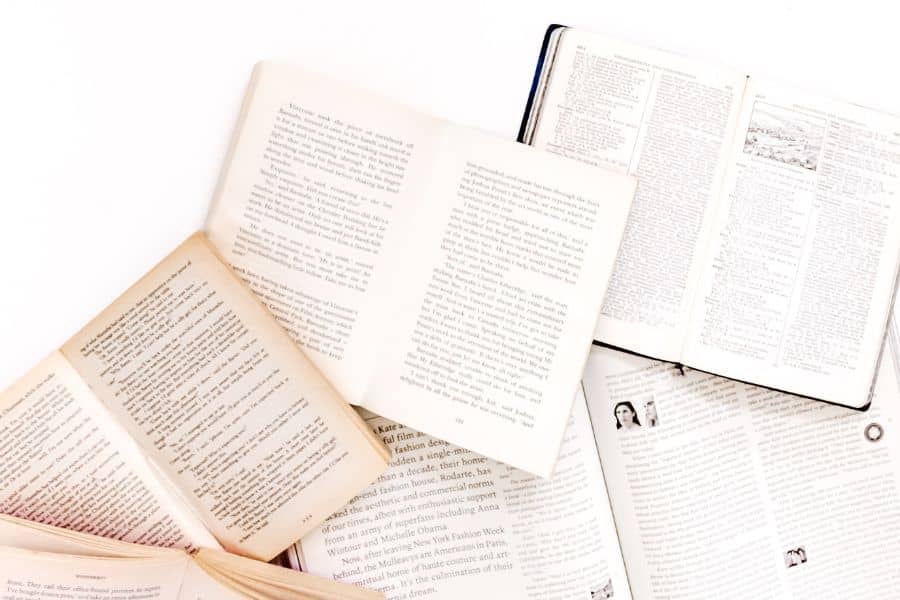Are you looking for epigraph examples that can help you add layers of texture to your writing?
Perhaps you want to make your writing more intriguing or use well-placed snippets to cultivate curiosity?
Then you’re in the right place.
When used skillfully, epigraphs can become your literary best friend. But there are no hard and fast rules about them, so they can be a tad tricky.
To master this art form, we’ll help you discover the what, why, and how of epigraph creation — complete with classic, vintage, and modern literary examples.
Are you intrigued? Well, follow me to learn more.

What is an Epigraph?
An epigraph, not to be confused with an epigram or an epitaph, describes a small text excerpt, usually preceding a novel, chapter or essay.
It’s often offset from the main content, and is in quotation marks.
An epigraph is a literary device that quotes another person’s work — be it the author’s or character captions from the story — and gives context to the reader about what’s to come.
Epigraphs often take the form of song lyrics, poetry, snippets from novels, or religious text.
Oddly, there are no strict rules on how an epigraph should look, but there are some guidelines.
How Do Writers Use Epigraphs?

Epigraphs are not mandatory but, when used artfully, can give us a flavor for the rest of the story.
The following ideas illuminate how writers use epigraphs:
- Put readers in the right mood — setting the stage for the story and aligning expectations.
- Give readers a preview — allowing the author to hint at the theme or drive readers toward the narrative.
- Provide readers with context — teaching them some essential background.
- Link the book to an existing body of literature — validating the story by linking it to religious or other authoritative texts.
- Add intrigue and mystery — giving clues to create anticipation and pulling the reader into the story.
- Give readers a whisper of the dialogue — allowing them a sneak peek into the story’s characters.
Famous Epigraph Examples
To better understand how to use epigraphs to improve your writing, here are our favorite examples in literature…
1. The Marriage Plot by Jeffrey Eugenides
“People would never fall in love if they hadn’t heard love talked about.”
— Francois de La Rochefoucauld
This first epigraph alludes to the fairy-tale notion of romance. It hints at the inner workings of Madeline, the main character and, a self-described “incurable romantic”.
“And you may ask yourself, “Well, how did I get here?”
And you may tell yourself,
This is not my beautiful house.
And you may tell yourself,
This is not my beautiful wife.”
— Song lyrics from The Talking Heads
The second epigraph suggests an illusion that escapes our minds when we dare to take stock of our lives — that things aren’t what they seem.
These ideas follow Mitchell, a religious studies major, throughout his quest to fill the spiritual void in his heart.
2. The House of Mirth by Edith Wharton
“The heart of the wise is in the house of mourning, but the heart of fools is in the house of mirth.”
— Ecclesiastes 7:4
This religious epigraph warns us against the foolishness found in mirth, or merriment.
It sets the theme of a story that takes us to the turn of the century in New York, where luxuriousness and grandiosity were attainable if one had the means.
Lily Bart, the main character, struggles with this world, to her a gilded cage.
Lily, a beautiful woman, is groomed to be more ornamental than useful – and finally rebels against this socialite plight.
3. The Great Gatsby by F. Scott Fitzgerald
“Then wear the gold hat, if that will move her; If you can bounce high, bounce for her too, Till she cries ‘Lover, gold-hatted, high-bouncing lover, I must have you!”
— Thomas Parke D’Invilliers (a fictional character from F Scott Fitzgerald’s This Side of Paradise)
This reminiscent epigraph in “The Great Gatsby” pokes fun at the showy nature of gaining a lover’s attention.
It’s a window into the story to come — the tale of an obscure millionaire, Jay Gatsby, who goes to extraordinary lengths to win back the affections of his former lover, Daisy Buchanan.
4. A Gate at the Stairs by Lorrie Moore
“All seats provide equal viewing of the universe.”
— Museum Guide, Hayden Planetarium
This epigraph could suggest competing for the best seat is pointless, or that wherever you are in the grand scheme of things, the bigger picture stays the same.
In this case, the epigraph doesn’t connect directly with the storyline — rather it intrigues and mystifies the reader.
The story, as narrated through the main character, Tassie Keltjin, gives us an insightful picture of a Midwestern college town from an unexpected perspective.
Tassie observes her world with a naïvety that she gradually sheds as the story unfolds and the wounds of her universe are exposed.
5. A Handful of Dust by Evelyn Waugh
“I will show you something different from either
Your shadow at morning striding behind you
Or your shadow at evening rising to meet you;
I will show you fear in a handful of dust.”
— T S Eliot, “The Waste Land”
By using this T S Eliot poem, Waugh sets the mood, allowing the reader to get a hint of the struggles ahead by showing you that fear exists in places unimaginable.
Our main character, Tony Last, loses his marriage to a parasitic man about town, John Beaver.
As Tony becomes disenchanted with the illusions he’s come to face, he sets out on an adventure to the Brazillian jungle — an expedition that changes his fate.
6. The God of Small Things by Arundhati Roy
“Never again will a single story be told as though it’s the only one.”
— John Berger
This great epigraph creates intrigue and mystery as it seeks to give the reader a glimpse of the multiple storylines playing out in this New York Times bestseller.

The God of Small Things is a great example of epic storytelling. An affluent Indian family is forever changed by a fateful day in 1969. The many themes running through this novel include a powerful family saga, a forbidden love story, and an insufferable political drama.
7. We the Animals by Justin Torres
“Now a boy is of all wild beasts the most difficult to manage. For by how much the more he has the fountain of prudence not fitted up, he becomes crafty and keen and the most insolent of wild beasts. On this account it is necessary to bind him, as it were, with many chains.”
— Plato, The Laws
This perfect epigraph sets the stage for a story about the wild nature of boys, and what the reader can expect from the main characters.
This coming-of-age story follows three boys as they plunge into bonds of fierce love, and grow into the people they must become.
8. Salvage the Bones by Jesmyn Ward
“We on our backs staring at the stars above,
Talking about what we going to be when we grow up,
I said what you wanna be? She said, ‘Alive.'”
— Outkast, “The Art of Storytellin’ (Part 1)”
In this case, the epigraph immerses the reader into a post-apocalyptic mood that matches the devastation this story is set in.
Salvage the Bones is a gritty story about a family barely subsisting in poverty, set in the 12 days preceding Hurricane Katrina.
Love is all but scarce in this is heart-wrenching novel about four motherless children doing their best to nurture, protect, and care for one another.
9. 1Q84 by Haruki Murakami
“It’s a Barnum and Bailey world,
just as phony as it can be,
But it wouldn’t be make-believe
if you believed in me”
— Billy Rose and E. Y. “Yip” Harburg, “It’s Only a Paper Moon”
This epigraph prepares us for a trip to an illusory world — while maintaining that our self-belief is our authentic foundation.
The story is narrated by a dyslexic teenage girl named Aomame, who’s influenced by the advice of a taxi driver. He suggests there are perplexing contradictions in the world around her — plunging her into a parallel existence she calls 1Q84, where “Q” represents the question mark.
10. Slouching Towards Bethlehem by Joan Didion
“I learned courage from Buddha, Jesus, Lincoln, Einstein, and Cary Grant.”
— Miss Peggy Lee
This epigraph foretells a story that summarizes lessons from iconic figures. Published in 1968, it introduces us to a group of essays that give us a sense of the mood and current flowing through 1960’s California counterculture.
In this nonfictional account of the 1960’s lifestyle, capturing the hub of the Hippie movement, Joan Didion explores the influences of iconic figures like John Wayne and Howard Hughes.
And you often find Joan ruminating over the push and pull between good and evil — all from a Death Valley motel room.
Epigraph Examples are The Icing on Your Literary Cake

The icing on a cake is what makes it appealing — similar to an epigraph.
An epigraph’s strategic and well-thought-out placement is the added insurance that promises your reader this will be a worthwhile read.
And now that you’ve seen this literary device in action, we hope you’ve found some illustrative examples.
So go out, grab that inspiration for your next literary creation, and sprinkle it with an epigraph that excites and delights your audience.
The post 10 Epigraph Examples To Add Texture & Intrigue (+ Definition) appeared first on Smart Blogger.

No comments:
Post a Comment